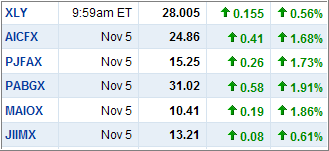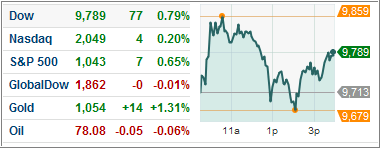
A convenient and efficient way to track sell stops has been on many readers’ minds. Tom had this to say:
How can I get a fund or ETF price automatically downloaded into my personal investment spreadsheet?
Setting sell stops based on new highs, etc. requires finding the price and manually entering it in the spreadsheet everyday. When I don”t look every day, I know I miss something.
Is this possible without subscribing to some high priced electronic quote system, etc.? (Free is good!) It seems with the tracking you do, there must be an obvious way to do this that I overlook.
I have Schwab and Fidelity, but I have not found a way to do this from their websites. There must be some software, program, or website that will pick up this info and put it into a spread sheet on your PC.
For many years, I have used a simple way to get that task accomplished. I have set up “My Yahoo” as a personalized page to track daily news events. Part of that set up includes a listing of funds/ETfs that I currently own and follow on a daily basis.
The funds/ETFs are listed by ticker, date, price and change for the day as the table above shows. It also includes a feature that lets you export this list to a spreadsheet, neatly arranged in columns to be copied and pasted wherever you like.
In your spreadsheet, you could use Tab1 to paste in all data, as I do, and use Tab2 to have your current holdings listed and formatted. By linking the prices in Tab1 to Tab2, you only need to go though one copy and paste process and your holdings are instantly updated.
Afterwards, I simply view my column titled high price to see if it needs updating, which I do manually. This obviously only comes into play during a market rally when new highs have been made.
Here’s what my matrix looks like using an actual purchase and a sell stop that got triggered:
[Double click to enlarge]
The columns are pretty self explanatory. The “High” column needs to be updated when prices make new highs, while the “Action” column is programmed to alert me to any changes in the status. In other words, when the 7% sell stop level has been broken, the “Hold” switches to “Sell,” giving me an easy identifiable alert when looking at a large list of items.
While I use other custom data bases to track these sell stops for a large number of funds/ETFs, this spreadsheet along Yahoo’s export feature is simple and effective and requires minimum time on your part once it is set up.






